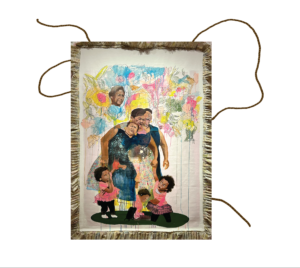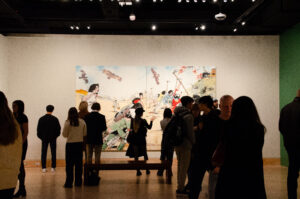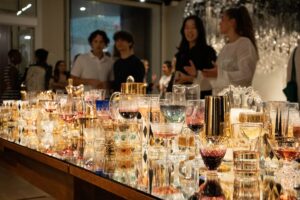Tucked away on the fourth floor of the National Museum of Women in the Arts, a passerby will find the Betty Boyd Dettre Library and Research Center (LRC), a quiet space reserved for reflection on the brave women of the arts. The show currently on display in the Library, Wonder Women!, is an exhibition of several female artists and authors who uniquely embody the values and chutzpah of the iconic superhero, Wonder Woman. Inspired by a Ms. magazine cover and the timely release of Wonder Woman on the big screen, Sarah Osborne Bender, director of the LRC, has curated a show that highlights all the things that define Wonder Woman as a woman and a hero.
Wonder Woman represents an especially feminine form of super-strength, and feminist icon Gloria Steinem loved her for that, choosing her to be the cover image for the first official issue of Ms. magazine. The cover, originally published in 1972 and rediscovered by Osborne Bender while researching for another exhibit, features a larger-than-life Wonder Woman charging to the rescue of citizens threatened by war. Wonder Woman’s image and character were the inspiration for this feature collection showing women of the arts who are “big, bold, brave, larger than life,” Osborne Bender wrote for the Museum’s Women in the Arts Fall 2017 magazine issue.
The show itself is divided into six case studies correlating to six different traits that define Wonder Woman. Each case study rests in its own glass case where viewers can look upon a few examples of art that embody the given trait being addressed. All of the examples provided come from the work of female artists, authors, and organizations, highlighting the parallels between the women featured and Wonder Woman.
The first case addresses “Superheroines” and features both a historic and modern example of other superheroines. Viewers will see an early 20th century illustration from Kathleen and the Great Secret, a serial story by Nell Brinkley that flipped the damsel-in-distress narrative on its head. The illustration, drawn in a soft yet dramatic style, shows Kathleen heading into action as a woman clings to her skirt. Its modern parallel, Bitch Planet, lays in the case as well, its brazen comic illustrations juxtaposed with the classic stylings of Kathleen. Bitch Planet, first published in 2015 and set on a prison planet, is a comic that follows the lives of rebel women who have been imprisoned for “non-compliance” with the patriarchy.
The second Wonder Woman quality is “Women of Myth/Making”, and features two artists who made art with an impact of mythic proportions. One such woman is Judy Chicago, who crafted her own myth in the 1970’s by changing not only her last name, but the female artistic narrative as a whole. Viewers see Chicago photographed as she saw herself: an intimidating, almost masculine figure standing in the corner of a boxing ring, ready to take on the competition. In a similar way, viewers can read a press release pulled from American Contemporary Art, where the work of the late Eva Hesse was almost deified in its praise. These women, like Wonder Woman, went beyond the conventional through their artistic and social impact, reaching almost mythic heights.
The next portion of the exhibit is titled “Women Take Action,” and examines the social actions of artists. The colorful Ms. magazine cover that inspired the exhibit is the focus of the room, alongside a recently published copy of Resist that promoted the 2016 Women’s March. The two alongside each other provide a poignant parallel between the actions and ideals of 70’s feminists and the all-too-similar fight that continues today. Together with these pieces lies a release by Guerilla Girls: Conscience of the Art World (1985), a brief exposé of the underrepresentation of women and women of color in the art world.
“Women at War” assembles a smashing series of color prints depicting the diligent women of WWII. The prints were pulled from a exposé for Life magazine by Edna Reindel which eventually made the basis for Rosie the Riveter, yet another classic feminine icon. The fifth case displays “Courage,” and the feature example is the story of Margaret Bourke White, a photographer active in the early and mid-20th century. White’s moment of courage came during the war on the roof of the US Embassy in Moscow, where she braved a German bombing for one night in order to document the siege. Alongside the recognition of White is a “broadside,” a printed poster with only one side of inking, by Chandler O’Leary and Jessica Spring. In the shape of a leaf, the broadside tells viewers “This is your moment. Seize it!” It was inspired by the actions of Barbara Rose Johns, who rejected and protested the conditions of her segregated high school in the 1960’s. As unalike as they are similar, White’s photographs and the commemorative broadside show that the courage of women comes in many different forms.
The show ends with the idea of “Larger than Life,” evocative of the towering Wonder Woman illustration that inspired this exhibit. Here we see the work of Anita Steckel, who overlaid images of the nude female body on New York cityscapes, seeking to shock the viewer. One photograph shows the roughly hewn image of a naked woman swinging across the city skyline, thighs wrapped around one particularly tall skyscraper. Through images like this, Steckel tried to juxtapose the masculine imagery of sharp city skylines with the curves of the feminine form, recasting our understanding of city imagery by expanding the idea of woman both visually and metaphorically.
While browsing the cases, surrounded by books and images of prominent women, it’s easy to get lost in their stories and art. The narrative of feminine energy here expands the idea of Wonder Woman into what is more inclusively Wonder Women. Whether revealed through photography, literature, or art, Wonder Women! is packed with inspiration, strength, and beauty. The exhibit shows, through both historic reminders and modern examples, that the artistic power of women is tangible and effective, beautiful and powerful. Despite the timeless value of a super heroine like Wonder Woman, this exhibit definitively shows that you don’t have to lie on the pages of a comic book to be considered a woman of wonder.





